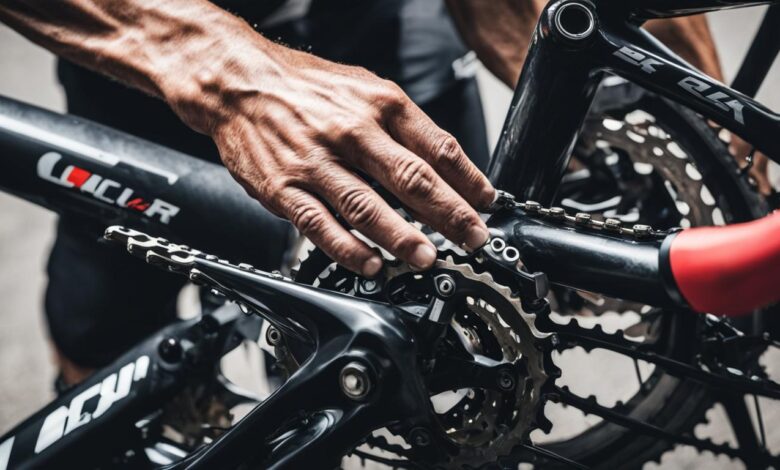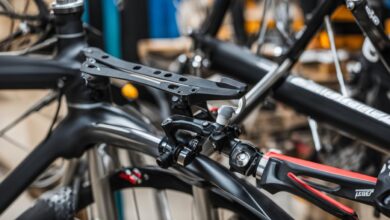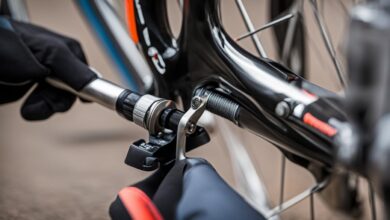Optimize Performance: Preparing Your Bike for Racing

Preparing your bike for racing is essential if you want to achieve peak performance on race day. Whether you’re a seasoned racer or just starting out, giving your bike the proper maintenance, tuning, and setup can significantly enhance its performance and make it race-ready. In this article, we will explore the essential steps and tips to help you optimize your bike for racing.
Key Takeaways:
- Perform regular maintenance to ensure your bike is in top working condition.
- Consider bike upgrades that can enhance your bike’s performance for racing.
- Tune your bike to suit the specific demands of the race.
- Set clear goals for your race to stay focused and motivated during training.
- Tailor your training to address the physical, mental, and technical aspects of racing.
Setting Goals for Your Race
Before you start training for a race, it is important to set clear goals for your event. Having well-defined goals will help you stay focused, tailor your training, and execute a race plan that aligns with your objectives.
When setting race goals, it is helpful to consider both outcome goals and process goals. Outcome goals are specific results or achievements you want to accomplish in the race, such as finishing in a certain time or position. These goals provide a clear target to work towards and can be a great source of motivation.
Process goals, on the other hand, focus on the specific actions and behaviors that will lead to success in the race. These goals can include things like improving your technique, maintaining a certain pace throughout the race, or staying mentally focused. Process goals help you break down the larger goal into manageable steps and provide a roadmap for your training and preparation.
When setting your goals, it is important to make them specific and relevant to your race. Consider the distance, terrain, and conditions of the race, as well as your own abilities and strengths. Setting goals that are just beyond your current capabilities can be challenging but also achievable, providing a sense of progress and accomplishment.
Example:
“My race goal is to finish in the top 10% of my age group and improve my personal best time by at least 5 minutes. To achieve this, my process goals include incorporating interval training into my weekly workouts, improving my hill climbing technique, and practicing mental strategies to stay focused and motivated during the race.”
By setting specific and relevant goals, you can not only enhance your motivation but also tailor your training to address areas that need improvement. It is important to regularly reassess and adjust your goals as you progress in your training and gain new insights about your capabilities.
| Benefits of Setting Goals for Your Race |
|---|
| 1. Provides motivation and focus |
| 2. Helps to tailor training and preparation |
| 3. Creates a sense of progress and accomplishment |
| 4. Enhances self-confidence |
| 5. Enables effective evaluation and adjustment of training strategies |
Setting goals for your race is an essential part of the preparation process. By having clear goals in mind, you can navigate your training journey with purpose and maximize your chances of achieving race-day success.
Tailoring Your Training for the Race
To prepare for a race, it is essential to tailor your training to meet the specific demands of the event. This involves focusing on physical, mental, and technical aspects to optimize your performance on race day.
Physical Training:
Physical training is the foundation for race preparation. It involves building endurance, strength, and speed to meet the physical demands of the race. Incorporating a combination of cardiovascular exercises, interval training, and strength workouts will help improve your overall fitness and performance.
Mental Training:
Alongside physical training, mental training is key to developing a strong mindset and overcoming psychological challenges during the race. Techniques such as visualization, positive affirmation, and setting race-specific goals can enhance your mental resilience, focus, and race-day performance.
Technical Training:
Races often have specific technical aspects that need to be mastered to enhance performance. This includes skills such as cornering, climbing, descending, and drafting. Incorporating technical training sessions into your routine, such as practicing on race-specific terrains or simulating race conditions, will help sharpen your skills and boost confidence.
Race-Specific Training:
Every race has its unique challenges and requirements. Tailoring your training to mimic race conditions will better prepare you for the event. This includes familiarizing yourself with the racecourse, practicing race-specific strategies, and simulating race scenarios during training sessions.
Training Plans:
Designing a well-structured training plan is crucial for effective race preparation. It should include a balance of different training modalities, rest and recovery periods, and progression over time. Working with a qualified coach or utilizing reputable training platforms can help ensure you have a comprehensive and tailored training plan for optimal performance.
| Week | Physical Training | Mental Training | Technical Training |
|---|---|---|---|
| 1 | Long steady-state rides | Visualization exercises | Cornering drills |
| 2 | Interval training | Goal setting and positive affirmations | Climbing technique practice |
| 3 | Strength training | Meditation and stress management | Descending skills development |
| 4 | Recovery week with light rides | Mental relaxation techniques | Drafting practice |
By incorporating physical, mental, and technical training into a well-planned training program, you can optimize your performance on race day and increase your chances of achieving your goals.
Bike Setup and Equipment
When it comes to racing, the technical demands on your bike are high. To ensure optimal performance, it’s crucial to carefully consider your bike setup and equipment. Here are some key factors to keep in mind:
1. Choosing the Right Tires
Selecting the appropriate tires for your race is essential. Different terrains and weather conditions require specific tire types and treads. Consult with experts or experienced riders to determine the most suitable option for your race.
2. Maintaining Proper Tire Pressure
Proper tire pressure is crucial for optimal performance and safety. Make sure to check your tire pressure regularly, as it can significantly impact your bike’s handling and traction on the road.
3. Carrying Essential Accessories
Carrying the right accessories is essential to address any unexpected situations during the race. A saddlebag or flat kit with spare tubes, tire levers, and a multi-tool can help you quickly fix minor mechanical issues and keep you on track.
4. Upgrading Your Bike Components
Consider upgrading your bike components to enhance performance. Upgrading parts such as the drivetrain, wheels, or brakes can provide better efficiency, aerodynamics, and overall performance. Consult with a bike shop expert to ensure compatibility and optimal results.
5. Regular Bike Maintenance
Maintaining your bike is crucial for both performance and longevity. Regularly clean and lubricate your drivetrain, inspect your brakes, check your cables, and ensure your bike is in optimal working condition. Regular maintenance will help prevent mechanical issues during the race.
By dialing in your bike setup and equipment, you can optimize your performance and ensure a safe and successful race.
Mental Strength and Race Psychology
Mental strength plays a crucial role in race performance. Training your mind to handle the psychological challenges of racing can greatly improve your ability to stay focused, overcome fears, and manage discomfort during the event.
One technique that can enhance your mental training for racing is visualization. By vividly imagining yourself executing perfect race strategies and achieving your desired outcomes, you can build confidence and reinforce positive racing behaviors.
Another important aspect of race-day psychology is overcoming fear. It’s natural to feel nervous before a race, but learning to channel that nervous energy into focus and determination can propel your performance to new heights. By acknowledging your fears and developing strategies to overcome them, you can transform fear into motivation.
Managing discomfort is another crucial skill for race-day success. Racing is physically demanding, and discomfort is inevitable. Training your mind to embrace discomfort and lean into the challenge can give you a competitive edge. Practicing in uncomfortable situations, such as training in adverse weather conditions or pushing through fatigue in training sessions, can help build mental resilience.
Developing a strong mindset is also essential for mental strength in racing. Cultivating qualities such as perseverance, determination, and self-belief will enable you to navigate setbacks and push through tough moments during a race.
In summary, mental strength and race psychology are integral components of race preparation. By incorporating techniques such as visualization, overcoming fear, managing discomfort, and developing a strong mindset, you can optimize your mental performance and achieve race-day success.
The Importance of Tapering
Tapering is a critical component when it comes to optimizing performance for races. It involves strategically reducing your training load in the weeks leading up to the event, allowing your body to recover from training fatigue while maintaining your fitness levels. By incorporating effective tapering strategies, you can significantly improve your performance on race day.
Research suggests that tapering can lead to performance improvements of up to six percent when done correctly. This reduction in training load helps your body repair and rebuild, leading to increased strength, power, and endurance. Additionally, tapering allows for a decrease in muscle inflammation and improves glycogen stores, providing you with the energy needed to perform at your best.
When implementing tapering, it’s important to consider the duration based on your training block. The ideal taper length may vary depending on the intensity and length of your training period. Generally, a taper duration of two weeks is considered optimal for most athletes. However, it’s crucial to customize the taper length based on your individual stress levels and training experience.
There are various tapering strategies to choose from, such as gradual reduction or step tapering. Gradual reduction involves gradually decreasing both volume and intensity of training over the taper period. This approach allows for continued stimulation of training adaptations while promoting recovery. On the other hand, step tapering involves a more rapid reduction in training volume, with a focus on maintaining intensity to sustain fitness gains.
By understanding and implementing the right tapering strategy and duration, you can fine-tune your body for race day, ensuring you’re in peak condition to perform at your best. Remember, tapering is not just a period of rest; it’s a strategic approach to reduce training load and achieve optimal performance.
Tapering Strategies:
- Gradual reduction tapering
- Step tapering
Timing and Duration of Tapering
Determining the timing and duration of tapering is essential for maximizing its benefits. Research suggests that an average taper length of two weeks is optimal, but the length may vary depending on the duration of the preceding training block. Identifying the day when training has a maximum positive effect on your race and the day when it starts to have a negative impact is crucial for planning your taper. Customizing the taper length based on individual stress levels and experience can further enhance its effectiveness.
The timing and duration of tapering require careful consideration to achieve the maximum positive effect on race day. Understanding how training adaptations occur and how they can impact performance is key to planning an effective taper.
“The optimal taper length depends on various factors, such as the duration and intensity of your training block, your overall fitness level, and your ability to recover,” says Dr. Lisa Thompson, sports physiologist and performance coach.
Training Adaptations and Maximum Positive Effect Day
During a training cycle, your body undergoes various physiological adaptations that improve your fitness and performance. These adaptations include muscular strength and endurance, cardiovascular efficiency, and improved lactate threshold. The maximum positive effect day represents the peak of these adaptations, where your body is primed for optimal performance.
By identifying the maximum positive effect day, you can strategically plan your taper to maintain these training adaptations while allowing your body to recover from fatigue. This prevents a decline in performance while ensuring you are fresh and prepared for race day.
Timing of Taper and Negative Impact Day
While tapering can have significant benefits, extending the taper for too long may lead to detraining effects, resulting in a decline in fitness and performance. This is why understanding the timing of the taper is crucial.
The negative impact day represents the point at which prolonged tapering can start to have diminishing returns on performance. It is important to avoid tapering for too long, as it can lead to detraining effects and a loss of peak fitness. Strike a balance between recovery and maintaining fitness by planning your taper with the negative impact day in mind.
Customizing the Taper Length
There is no one-size-fits-all approach to tapering. Individual factors such as stress levels, experience, and training history can affect how your body responds to tapering. Therefore, it’s crucial to customize the taper length to optimize its effectiveness.
Consider factors such as your susceptibility to fatigue, your ability to recover, and your mental readiness for race day. By tailoring the taper length to your specific needs, you can maximize the benefits and arrive at the start line feeling fresh, confident, and ready to perform at your best.
Take a look at the table below for a visual representation of tapering duration and its impact on performance:
| Taper Duration | Performance Impact |
|---|---|
| Less than 1 week | Detrimental effect on performance |
| 1-2 weeks | Optimal taper length for most athletes |
| 2-3 weeks | Minimal loss of fitness, but potential detraining effects if extended |
| More than 3 weeks | Risk of detraining effects and loss of peak fitness |
Remember, the key to a successful taper is finding the right balance between recovery and maintaining training adaptations. By understanding the timing and duration of tapering, you can optimize your race readiness and maximize your chances of a peak performance on race day.
Crash Training and Carb Loading
Crash training, also known as overload training, can be a valuable strategy for serious cyclists aiming to enhance their performance before a race. Research has demonstrated that implementing a period of intense training just before the taper can lead to significant improvements in performance. By pushing your limits and challenging your body’s capabilities, you can stimulate adaptations that translate into enhanced race-day performance.
However, it is essential to follow crash training with an appropriate taper in order to fully reap its benefits. The taper allows your body to recover and adapt to the increased training load, ensuring that you reach peak performance on race day.
While physical training is crucial, proper nutrition also plays a key role in race preparation. Carbohydrate loading, a technique that aims to optimize glycogen levels in the muscles, can provide a valuable source of fuel for your race. While traditional carb loading methods may not be suitable for everyone, timing carbohydrate intake immediately after high-intensity exercise has been shown to effectively replenish glycogen stores.
Timing carbohydrate intake immediately after exercise is particularly important because during this time muscle glycogen is greatly reduced, and the muscles are primed for glycogen synthesis.”
By strategically managing your nutrition and fueling your body with the right nutrients, you can ensure that your glycogen levels are optimized for race day.

Crash Training and Carb Loading: A Winning Combination
Integrating crash training into your race preparation can supercharge your performance, while carbohydrate loading ensures that your body is adequately fueled for the demanding race ahead. By combining these two strategies, you can optimize your glycogen levels, enhance your endurance, and improve your overall race-day performance.
Conclusion
Preparing your bike for racing and optimizing your performance require a comprehensive approach that addresses physical, mental, and technical aspects. By setting clear goals, tailoring your training, optimizing your bike setup, and incorporating mental training techniques and tapering strategies, you can enhance your race-day performance. Remember, race preparation is a continuous process, and with the right approach, you can achieve race-day success and unlock the full potential of your bike.
FAQ
How important is it to prepare my bike for racing?
Preparing your bike for racing is crucial to ensure peak performance on race day. Proper bike maintenance, tuning, and setup can enhance your bike’s performance and make it race-ready.
What should I consider when setting goals for my race?
When setting goals for your race, it is important to consider both outcome goals (such as finishing time or position) and process goals (such as focusing on specific performance aspects). Clear and relevant goals will help you tailor your training and execute a race plan aligned with your objectives.
How should I tailor my training for a race?
To tailor your training for a race, you need to consider the physical, mental, and technical demands of the event. This involves understanding the specific challenges and requirements of the race and designing a training plan that targets those areas.
What factors should I consider for my bike setup and equipment?
For race preparation, it is crucial to ensure your bike and gear are suitable for the specific race you’re participating in. This includes selecting the right tires, maintaining proper tire pressure, carrying essential accessories like a saddlebag or flat kit, and considering bike component upgrades if necessary.
How can I improve my mental strength for racing?
Mental strength plays a vital role in race performance. Techniques such as visualization, practicing in uncomfortable situations, and developing a strong mindset can help you build mental resilience and perform at your best on race day.
What is the importance of tapering before a race?
Tapering, which involves reducing training load before a race, is crucial for optimizing performance. It allows your body to recover from training fatigue while maintaining fitness levels, resulting in improved performance on race day.
How do I determine the timing and duration of my taper?
Determining the timing and duration of your taper is essential. Research suggests that an average taper length of two weeks is optimal, but the length may vary based on your training block. Customizing the taper length based on individual stress levels and experience can further enhance its effectiveness.
What is crash training, and how can it benefit my performance?
Crash training is a period of intense training immediately preceding the taper. Studies have shown that overload training followed by an appropriate taper can lead to significant performance improvements.
How does nutrition play a role in race preparation?
Nutrition is a crucial aspect of race preparation. While traditional carb-loading methods may not be suitable for everyone, timing carbohydrate intake immediately after high-intensity exercise can optimize glycogen storage levels for race day.
What is the key to race preparation success?
The key to successful race preparation is a comprehensive approach that addresses physical, mental, and technical aspects. Setting clear goals, tailoring your training, optimizing your bike setup, and incorporating mental training techniques and tapering strategies can enhance your race-day performance and unlock your bike’s full potential.




